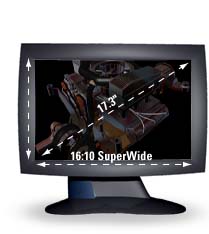Fall Comdex '98 Coverage
by Anand Lal Shimpi on November 21, 1998 11:19 AM EST- Posted in
- Trade Shows
What do these two companies have in common? In browsing the suites of the Las Vegas Convention Center waiting for a meeting with AMD, I noticed an interesting combination of names, the graphics accelerator giant and the graphics manipulation monster, Number Nine and SGI, were sharing a suite. On display at SGI's suite, in addition to the multitude of O2 workstations rendering objects in 3D at unbelievable speeds (unbelievable to your average x86 user that is) SGI had a very unique little device on display: the Number Nine Revolution IV and Digital LCD Display combo.
The Number Nine Revolution IV card has been thoroughly torn apart by most editors and reviewers due to its obviously horrendous 3D gaming performance in comparison to most other next generation graphics accelerators. However, if you remember back to the days of the Number Nine Imagine 128, when 2D performance and especially 2D image quality were top notch considerations for a new video card, Number Nine was on top of the game...and after what was displayed at Comdex, to a certain degree, they still may be. The 32MB Revolution IV, while boasting 3D performance that makes an i740 look like a Voodoo2, has some of the most crisp, clear, and definitely enjoyable 2D image quality (and performance for that matter) on the market today. While more extensive benchmarking is necessary to put it in its place in comparison to Matrox's G200 and the newer TNT cards, the Revolution IV does much more than boast above average 2D performance. Its built-in digital out port (in addition to the standard analog VGA port) allows for a direct digital connection to flat panel LCD displays, more specifically, it is the only video card that supports SGI's newest 17.3" SuperWide Flat Panel LCD, in digital mode.
| This monitor put my Panasonic 21" to shame, easily adjusting to the highest supported resolution of 1600 x 1024 in true color, the monitor, in combination with the Revolution IV video card, allowed for some of the most intricate Photoshop images to be displayed and scaled without losing either performance or quality. Unlike conventional LCD displays which interface through your video card's analog-out port, this flat panel is a true digital solution, allowing for extremely fast pixel response, an extremely high DPI rating (110, meaning for every inch of space on the monitor, 110 individual dots can be displayed), and of course, as a result of its unique size, this monitor has support for resolutions outside of the conventional 1024 x 768 limit without any loss of image quality. |  |
So who cares if Number Nine can offer outstanding 2D quality and performance? Well, seeing is believing, this product and/or the combo is not meant for hard core gamers, rather the corporate market. Currently there are no real popular contenders of this kind in the market, forcing many professionals to use gaming cards to accomplish their tasks, often times without the high quality they desire. Have you ever tried reading 8 or 10 pt white text on a solid black background running at 1600 x 1200 in true color on a TNT based card? Try it sometime, and imagine being able to read the text as clearly as you can read the words from a book in front of you, you're imagining the quality of this graphics accelerator.
This product truly blew me away, with so little attention given to monitors in spite of all of the publicity choosing the best graphics accelerator is allowed it isn't often that you hear about a product like this. Shortly AnandTech will review the Number Nine Revolution IV and put it through a fair testing process in both 2D and 3D situations, with the usefulness of Graphics Winbench 98 coming to an end as all video cards produce seemingly equal scores, it is time for a change in 2D benchmarking, a change AnandTech will bring you.










0 Comments
View All Comments